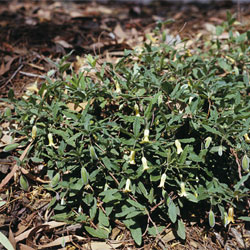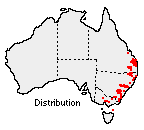Billardiera scandens
 |
 |
Apple Berry, Apple Dumplings
Billardiera is a genus of around 40 mostly climbing species all endemic to Australia, in the family Pittosporaceae. Although most Billardiera species occur naturally in the southwest of Western Australia, Billardiera scandens is a common and widespread species of the eastern states of Australia.
 The
range of the species extends from south Queensland to Tasmania, and South Australia. B. scandens can be found in habitats ranging from coastal heath to sclerophyll
forest and inland mallee. Common names include Appleberry, Apple dumpling and
Snotberry. Aboriginal names include Bomula (Sydney region) and Karrawang (Victoria).
The
range of the species extends from south Queensland to Tasmania, and South Australia. B. scandens can be found in habitats ranging from coastal heath to sclerophyll
forest and inland mallee. Common names include Appleberry, Apple dumpling and
Snotberry. Aboriginal names include Bomula (Sydney region) and Karrawang (Victoria).
The species is an evergreen sprawling groundcover or climber, with wiry, red to brown-grey stems up to 3 metres long. In an open position the form may take that of a small shrub to 1.5 m high. The shoot tips are very hairy, with a fine white fringe.
Pendulous bell-shaped flowers develop on the end of stems or on short branchlets in spring and summer. These 1-2 cm long flowers are borne on slender stalks, singly or in groups of 2-3. Each flower has five bright yellow-cream petals that tinge with purple as the flower ages. The petal tips reflex as the flower opens.
Flowers may persist on the plant as the first fruit develop. An oblong berry, 2 cm long and 1 cm wide forms in summer. The fleshy green and purple fruit turns yellow when ripe. Fruit may be eaten raw when it has fallen to the ground, or roasted if still green. The skin is hairy and similar to peach and the sweet astringent flavour similar to kiwifruit.
The hairy leaves are narrowly oval, mid green, 0.5 cm wide and 5 cm long. The leaves have a wavy, sometimes recurved margin. The underside of the leaf is pale-green and silky.
Tolerance of a range of conditions and a climbing but not invasive habit make this plant a useful addition to any garden. Billardiera scandens is suitable as a climber over other plants or as an attractive potted, hanging basket or rockery specimen. Planted under Eucalyptus, cultivated Billardiera scandens can thrive under conditions challenging for most garden plants. Honeyeaters are attracted to the nectar.
Naturally occurring plants in dry, shaded or cool positions often develop sparse foliage. In cultivation, however, regular pruning and watering in a sunny position will improve growth. The species is frost tolerant to -7° C, and is hardy in most free draining soils. Billardiera scandens benefits from mulching and light applications of blood and bone or slow-release Australian native fertiliser. No specific pest or disease problems have been noted however avoidance of overhead watering discourages fungal problems.
Propagation is more difficult for B. scandens than other Billardiera species. Summer sown seed may take up to 12 weeks to germinate in autumn. Treatments such as washing dried seeds in detergent, or straining seed after fermentation in water for two weeks may improve germination. Firm tip cuttings may be taken in summer.
Text by Leanne Brown (2002 Botanical Intern)
Name meaning: Billardiera scandensBillardiera - after J.J.H. de Labillardiere (1755-1834), a French Botanist. scandens - from the Latin scandere, 'to climb'. |
References
Cosgrove, Craig. Pers. Comm. 18 February 2002. Gardens Depot, Australian National Botanic Gardens, ACT.
Elliot, W. Roger and Jones, David L. (1982). Encyclopaedia of Australian Plants Suitable for Cultivation Volume 2.Lothian Publishing Co. Pty. Ltd., Sydney.
Friends of the Aranda Bushland (1997). Our Patch. Friends of the Aranda Bushland Inc. ACT.
Harden, Gwen J. (ed.) (1992). Flora of New South Wales Volume 3. New South Wales University Press, Kensington NSW.
Isaacs, Jennifer. (1994). Bush Food Aboriginal Food and Herbal Medicine. Lansdowne Publishing Pty. Ltd., Sydney.
Jones, D.L. and Gray, B. (1984). Australian Climbing Plants. Reed Books Pty Ltd, Frenchs Forest NSW.
Low, Tim. (1995). Wild Food Plants of Australia. Angus and Robertson, Sydney.
Robins, Juleigh. (1996). Wild Lime: Cooking From the Bushfood Garden. Allen and Unwin, St Leonards, NSW.
Smith, Keith. (1999). Grow Your Own Bushfoods. New Holland Publishers, Sydney.
Wrigley, John W. and Fagg, Murray. (1998). Australian Native Plants: Propagation, cultivation and use in landscaping, 4th Edition. Reed New Holland Publishers, Sydney.
![An Australian Government Initiative [logo]](/images/austgovt_brown_90px.gif)

